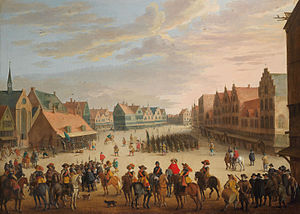| Scots Brigade aka Anglo-Dutch Brigade aka Anglo-Scots Brigade | |
|---|---|
 Scots mercenaries in Utrecht, 1618 | |
| Active | ca 1586–1782 |
| Country | |
| Branch | Army |
| Type | Infantry |
| Size | Brigade; between three and six regiments |
| Garrison/HQ | Dutch Barrier forts |
| March | The "Scottish March" |
| Engagements | |
| Commanders | |
| Notable commanders | Earl of Leicester Francis Vere Lt-General Hugh Mackay |
The Scots Brigade, also referred to as the Anglo-Dutch Brigade or the Anglo-Scots Brigade,[1] was an infantry brigade of the Dutch States Army. First formed in 1586, by the late 17th century it usually comprised six infantry regiments, three recruited primarily from Scotland and three from England. It was finally dissolved in 1782 following the outbreak of the Fourth Anglo-Dutch War.
Throughout the 16th and early part of the 17th centuries, units of foreign mercenaries were commonly used by all European powers. Domestic opposition to permanent armies as a result of the 1638–1651 Wars of the Three Kingdoms meant British monarchs used the Brigade to create a pool of trained officers, who could be called on when needed. However, in the early 18th century, increasing demand meant permission to recruit in Britain was restricted on a number of occasions and finally banned after 1757.
After the end of the War of the Spanish Succession in 1714, the Brigade was reduced to three regiments and primarily used to garrison the Barrier forts. By 1782, many of its officers were British, often from families with a long tradition of service with the Brigade, but the vast majority of the rank and file were Dutch-born. It became regiments 22, 23 and 24 of the regular Dutch army and after 1784 ceased to be a separate unit. Their traditions and battle honours were continued by the 94th Foot until 1881, when the 94th became part of the Connaught Rangers.
- ^ Ede-Borrett 2011, p. 278.
